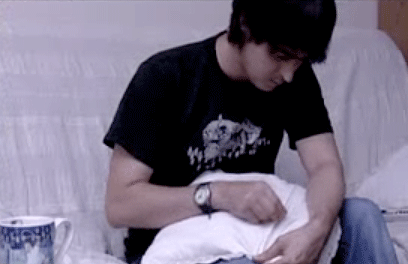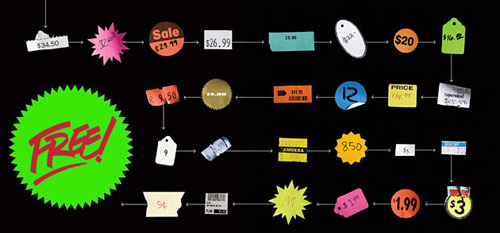Notes on Deeves’s “Beats of Boredom,” by Eduardo Navas

Image still of “Beats of Boredom” by Adams Deeves
The music video “Beats of Boredom” by Adams Deeves has been circulating among online video sites for some time now. Some sites where it can viewed include I-am-bored, Vimeo, and Youtube.
The video was created with clips of a man who finds himself at home with nothing to do. He does what most people who are bored would do: watch TV, eat a not so healthy snack, and then do some cleaning. The originality of “Beats of Boredom” is in the way the sequences are edited, which are built on top of each other rhythmically as new moments of the boring afternoon are introduced. The end result is a music video of an instrumental song clearly influenced by hip hop and variations of house that ordinarily would go unnoticed, were it not for the fact that the sounds were produced with household items.
The video starts with a series of water drops, then the man plays with a small radio, cut to the sound of a tea kettle, then the man scrapes a toast, sits and eats in front of the TV, wondering what to do; then he slaps his right hand on his right leg: once, twice–then hits his chest with his fist, and snaps his fingers; then he opens and closes the zipper of a sofa pillow to mimic the sound of a record being scratched, then he slaps the pillow, creating a similar sound to a base drum; and repeats the whole process. At this point we have the basic rhythmic structure of the music composition in place, and it is a matter of adding other elements on top.
Other activities include placing a CD player in a stereo system, turning on a printer, scratching a jacket’s sleeve with his index finger, going to the refrigerator to look for something to eat, then opening what appears to be a beer bottle; then flipping the pages of a closed note book with his thumb–and turning on and off a vacuum to make the sound of a DJ quickly cutting the sound level on a mixer.
At the end he is asked by a woman who comes into the apartment “What are you doing?” He replies “what?” she repeats, “what are you doing?” he replies, “nothing.”
This video shows how material activities attain value, which in this case consists of careful repetition of sound recordings from an uneventful day. A slap does not mean much if performed once, but when repeated it becomes a vehicle of representation. When this is recognized as a creative possibility, a second, third and fourth slap could follow, and this is the basis of rhythm. Repetition of activities, whether in music or other areas of culture, is necessary to create value–or more simply meaning. Repetition becomes even more stable and efficient when recording technology is used to preserve image and sound for replay.
What we encounter in “Beats of Boredom,” then, are all the necessary elements for any activity to become and be repeated as a mix, and eventually a remix. Most importantly, the video is already a remix because it is composed of samples from a boring day, and in order to understand it as a composition, it is necessary to not only listen to the sound, but also view the video clips as the sound samples are added on top of each other. “Beat of Boredom” gives equal weight to, both, image and sound, something not always accomplished successfully by either music or video artists. Nevertheless, “Beats of Boredom” is primarily a video, which shows how with recording technology one has the power to take representation and manipulate it, mix it and remix it. And once “Beats of Boredom” is repeated enough and becomes recognizable it will enter the realm of the spectacle, and will be prone to becoming remixed or simply consumed passively, not because of its innovation, but because of its recognition as a popular composition.
Thanks to Greg J. Smith for turning me to this work.











